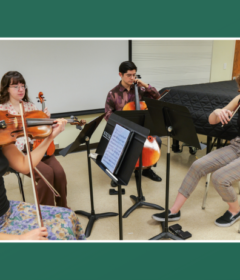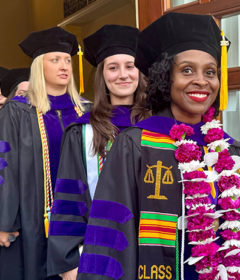Protecting the coastal environment
On Thursday afternoon in Gulfport, Gary Lytton, the director of the Rookery Bay National Estuarine Research Reserve in Naples, Fla., talked with Stetson Law students in the Great Hall about the struggle to protect the coastal environment and one of the few remaining undisturbed mangrove estuaries.
Lytton discussed the tug-of-war between coastal development and environmental preservation.
“It really is like managing a balancing act,” Lytton told the audience. “One of the biggest challenges is managing water. Fertilizers and heavy metals in the water cause problems in the estuary.”
Lytton was visiting campus to deliver the first lecture of the semester in the Edward and Bonnie Foreman Biodiversity Lecture Series at Stetson. He oversees the Rookery Bay, one of 28 estuarine reserves established by partnerships between the National Oceanic and Atmospheric Administration and coastal states in the U.S. The Feb. 9 event was co-sponsored by the Environmental Law Society and the Institute for Biodiversity Law and Policy at Stetson.
“An estuary is among the most productive biological resources on the planet, and human land use has a direct impact,” Lytton shared.
Lytton explained how an important part of his work at the estuary is educating people. By training landscape professionals about fertilizer and pesticide pollution, directing boaters away from delicate sea grass beds, and enlisting a team of volunteer boaters to monitor the estuary, Lytton said that he hopes that the Rookery Bay can have an impact on improving water quality all along the coast.
“Education helps raise awareness about aesthetic, environmental, and quality-of-life values that come with protecting our natural resources,” said Lytton.
He also explained projects developed to protect wildlife and to restore the Everglades ecosystem, of which Rookery Bay is a part. Non-native Australian pines were removed to improve sea turtle breeding along the beach. Australian pines, uprooted easily because of their shallow root structures, frequently fell during storms and made the beach impassable to sea turtles attempting to nest there. Removing the non-native trees made it easier for the turtles to lay their eggs. After the Deepwater Horizon oil spill in the Gulf, Lytton said that the Rookery Bay was able to provide a safe haven for rescued sea turtles.
Lytton explained that there is a direct connection between human use and behavior in respect to the environment. Water pollution from farming outside Chicago, for example, can have an impact on the Mississippi River, contributing to a massive “dead zone” hundreds of miles away.
Lytton also explained how humans can have a positive impact on native habitats. He told the students how conducting controlled burns in the Rookery Bay habitat mimics the natural lightning strikes that native trees have adapted to over hundreds of years.
“Some seeds only germinate after exposure to fire,” Lytton said.
Rookery Bay is home to a 16,500 square-foot Environmental Learning Center with four research laboratories, classrooms, a 140-seat auditorium, and a two-story visitor center. The visitor center is home to a 2,300-gallon aquarium and interactive exhibits addressing research and stewardship efforts ongoing within the Reserve, as well as a nature store, gallery and picnic area.
The Reserve works in partnership with local coastal communities for the promotion of coastal stewardship through land management, research and education.
Interim Law Dean Royal Gardner created the Edward and Bonnie Foreman Biodiversity Lecture Series and serves as director of the Institute for Biodiversity Law and Policy at Stetson. He is the author of the recently published book, Lawyers, Swamps, and Money: U.S. Wetland Law, Policy, and Politics.
Stetson offers an environmental law certificate of concentration, and is also the host of the Journal of International Wildlife Law and Policy. Students edit articles submitted by academics, policy makers, and scientists.
For more information about environmental law at Stetson, visit the Institute for Biodiversity Law and Policy.



